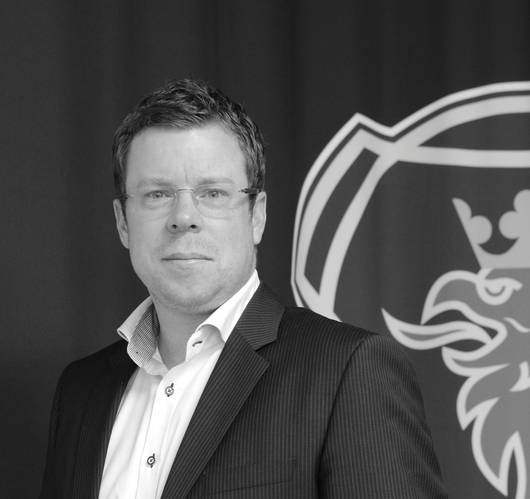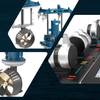SCANIA Powers Ahead in Workboat Market
Power providers are excellent bellwethers of the market at large, and according to Mikael Lindner, President, Scania USA, there are positive signs on the marine industry horizon.
Scania USA today finds itself in an interesting position in the United States. While the parent company is a global powerhouse, with more than 40,000 employees worldwide and an enviable base of technological prowess and business success across many industries, in the U.S. workboat market Scania USA is in some regards still are relatively new but up and coming brand.” According to Mikael Lindner, President of Scania USA and seated in its North American HQ in San Antonio, he is excited by the tremendous opportunity before his team to further penetrate established and new markets.
“One of the key differences I find with Scania is that we live and breathe our core values: the customer first, quality, and respect for the individual,” said Lindner. “We are relatively new in the U.S. We have an excellent product, but we have to over perform in everything that we do.”
Scania USA has registered strong growth in the U.S. in the past few years, expanding its network of dealers and distributors to more than 300. While this admittedly has been powered more on its industrial and power generation sectors, Lindner is seeing signs of growth in key marine markets and the marine network has grown.
“This year has been pretty good for marine, as I think we will do record sales even though the marine market is still stable at a low level,” Lindner said. “There are though positive signs for sure.”
Specifically, Lindner sees increased investment in projects across the board. “Last year there was a lot of activity but no one really pulled the trigger on projects,” he said. “Also, some projects that have been discussed for many years are starting to materialize this year.”
As the market picks up, the company is well positioned geographically to not only sell, but to service and maintain a growing and diverse client base.
“We have invested in a wide service network because if we don’t do that, and we fail, then we are not going to be here anymore. We are here for the long run, so we put a lot of focus on support, after sales and installation.”
Key to Scania’s success in the marine sector has been its partnerships, and Lindner was quick to point out the value of its distributors.
“Our distributors have done a great job in making Scania successful within their markets, specifically the patrol craft sector previously, and now also in the workboat market in the gulf region, where there has always been a lot of untapped potential for Scania. Passionate distributors are, and will be the key to our success,” Lindner said.
With a modern engine line, a growing market and a strong partner, Linder looks forward in a positive frame of mind. “As that market recovers, there are many opportunities for repowers on traditional workboats.”
Engine Innovation
Providing engines that meet and beat emerging environmental and emission regulations is simply the price of entry in today’s marine power business. Long term players must accomplish this while simultaneously maintaining favorable fuel consumption numbers, and providing package solutions for those who want them.
“We deliver engines and instruments, and can deliver controls and gearboxes,” said Lindner. “We basically stop where the propeller shaft starts.”
The evolution of the marine propulsion maker as a single source stop for the complete power system is actually a topic of keen interest to Lindner, as he studied and followed these types of matters in detail when he was based in the factory. “One of my main activities at the factory was to look at the market and determine what was happening in terms of customer and market requirements,” he said. As Scania studied the market and considered its options, they made the conscious decision to keep the focus on the engine, instruments, controls and gearbox for a very good reason.
“For propulsion, we looked at boatbuilding up to a certain length where our engines could serve as propulsion source and we realized that boat builders were accustomed to buying shafts and propellers, and frankly, if you do that (seek to supply shafts and propellers), you take on a huge responsibility regarding the boat’s performance. As a diesel engine manufacturer, if we start delivering shafts and propellers, we could be responsible for the speed of the boat.” He explained that this is perhaps a consideration in the pleasure boat sector, where hulls are massed produced, but a riskier call in the commercial market, where there are many one-off boat designs.
Though Scania can provide packages, make no mistake that the core of the business is the development, manufacture and servicing of superior engines, and with emerging Tier 3 and Tier 4 regulations looming, much thought and attention is paid here.
“Most of the recent discussions have been on Tier 3 as it is connected to Tier 4 in 2017, determining how we line up the products strategy for Tier 3 versus Tier 4,” Lindner said.
With that, the company in early August announced that its engine range for EPA Tier 3 is the latest addition to the Scania marine engine range. The engine range consists of a robust 13 liter Inline six and a powerful 16 liter V8 for use in both marine propulsion and marine auxiliary applications. These new engines will conform to upcoming EPA Tier 3 emission legislation for engines in North America which will come into effect on January 1, 2014 for engines in the power bracket 75 kW to 3000 kW, and 1.2 to 2.5 liters of displacement per cylinder.
And while engine development is the necessity to open the door to a business relationship, Lindner leans back on Scania’s core values and customer-centric approach when describing his approach to keeping owners for the long haul; after sales service of the customer base is crucial.
“Service is going to sell engines, and products. Everyone is going to have challenges, but it’s about the way you react, and the solution you provide your customers, that will make you stand out. No one is going to be perfect,” he concluded.
(As published in the September 2013 edition of Maritime Reporter & Engineering News - www.marinelink.com)
















